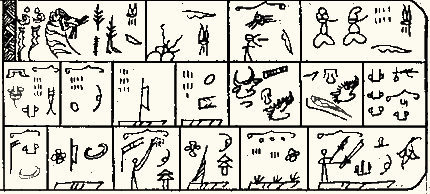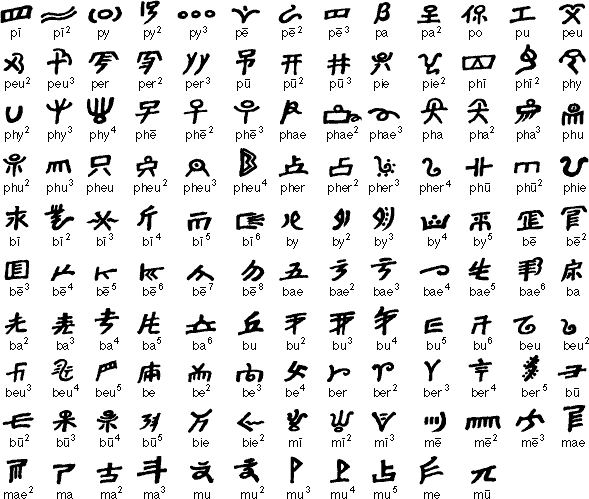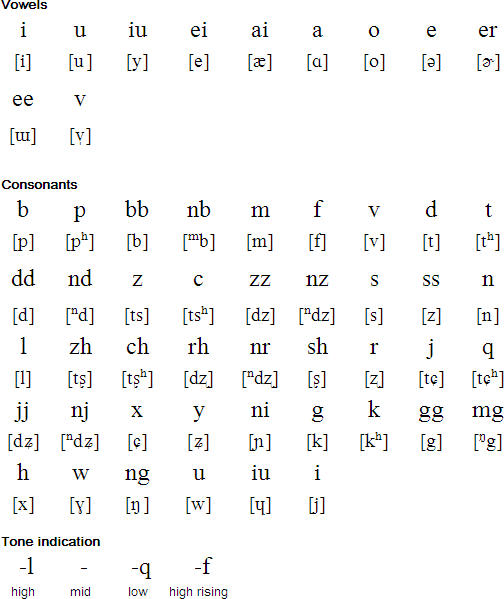Naxi is a member of the Yi branch of the Tibeto-Burman language family. It is spoken by about 300,000 people in the Chinese provinces of Yunnan and Sichuan, particularly in the Lijiang (丽江) region. There are also Naxi people in Tibet and possibly in Burma/Myanmar.
Naxi has been written with three different scripts:
The Naxi Dongba script (a.k.a. Tomba or dto-mba) was reputedly invented by King Moubao Azong in the 13th century. It is used exclusively by the Dongba (shamans/priests) as an aid to the recitation of ritual texts during religious ceremonies and shamanistic rituals.
Use of the Naxi language and script was discouraged after the Communist victory in 1949, and they were actively suppressed during the Cultural Revolution in the 60s when thousands of manuscripts were destroyed.
Today there are about 60 Dongba priests who can read and write the Dongba script. Most are over 70, though at least three are under 30. In an effort to revive the script, the younger Dongbas frequently visit local schools in the Lijiang region to teach classes on it.
A newspaper was published during the 1980s printed in the Dongba script and the Latin alphabet in an attempt to increase the level of literacy among the Naxi people in their own language. Over 30 books were also published. There efforts were successful at first - in 1982, 200 people could read Naxi in the Latin alphabet. By 1985, 1,700 could do so. The Chinese government phased out Naxi language teaching in the late 80s, but recently effort have been made to start teaching the language again.
The script is also used on road signs and shop names in Lijiang.

The Geba script is structurally similar to Chinese and contains a mixture of symbols derived from Chinese characters, independently invented symbols and simplified pictographs taken from the Dongba script. Few examples of texts in the Geba script are known, so the script is little understood.


A version of the Latin alphabet based on Pinyin was introduced to write Naxi in 1957 and revised in 1984.

Download an alphabet chart for Naxi (Excel)
Details provided by Michael Peter Füstumum, with corrections by Wolfram Siegel
Source: https://zh.wikipedia.org/wiki/納西語
Naqxi tei'ee jju pil gguf, Naqxi balzhee tv ceeq sie. Naqxi tei'ee Naqxi bal, sseiweq leq gee dde bbaq leq bbaq ssi ddee ddoq nee, Naqxi xiyuq huahuaq.
Translation
Since the Naxi people have their own script, they publish a Naxi newspaper.
The Naxi script newspaper is as beautiful as a blooming flower. Seeing
this beautiful flower, we know that the life of the Naxi people will
be joyful.
Information about Naxi | Numbers
Information about Naxi
http://www.sinoglot.com/naxi/
https://en.wikipedia.org/wiki/Naxi_language
https://zh.wikipedia.org/wiki/納西語
Information about the Naxi Dongba script
http://www.wiedenhof.nl/ul/chtk/nieuws/dongba/
http://www.loc.gov/loc/lcib/9906/naxi1.html
http://www.sinoglot.com/naxi/wp-content/uploads/2009/11/copybook.pdf
edongba - software for typing the Naxi Dongba script
http://www.naxidongba.com
Naxi dongba fonts
http://www.efword.com/tompa/font/
Naxi Manuscript Collection in The Library of Congress
http://international.loc.gov/intldl/naxihtml/naxihome.html
Information about the Naxi people
http://www.china.org.cn/e-groups/shaoshu/shao-2-naxi.htm
http://en.wikipedia.org/wiki/Naxi
Information about and photos of Lijiang
http://www.terragalleria.com/asia/china/lijiang/lijiang.html
http://www.globaltravelwriters.com/Galleries/Lijiang/
Arakanese, Balti, Chocha Ngacha, Drung, Hajong, Hmar, Jingpho, Lepcha, Lhao Vo, Lhomi, Magar, Manipuri, Mro, Naxi, Newar, Pahari, Tangkhul Naga, Tujia, Yolmo
Akkadian Cuneiform, Ancient Egyptian (Demotic), Ancient Egyptian (Hieratic), Ancient Egyptian (Hieroglyphs), Chinese, Chữ-nôm, Cuneiform, Japanese, Jurchen, Khitan, Linear B, Luwian, Mayan, Naxi, Sawndip (Old Zhuang), Sui, Sumerian Cuneiform, Tangut (Hsihsia)
Languages written with the Latin alphabet
Page last modified: 15.03.23
[top]
You can support this site by Buying Me A Coffee, and if you like what you see on this page, you can use the buttons below to share it with people you know.

If you like this site and find it useful, you can support it by making a donation via PayPal or Patreon, or by contributing in other ways. Omniglot is how I make my living.
Note: all links on this site to Amazon.com, Amazon.co.uk
and Amazon.fr
are affiliate links. This means I earn a commission if you click on any of them and buy something. So by clicking on these links you can help to support this site.
[top]